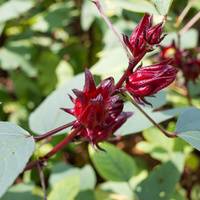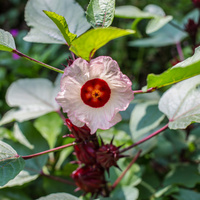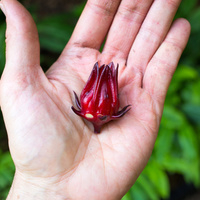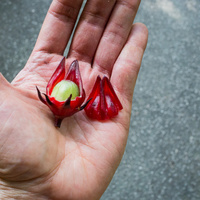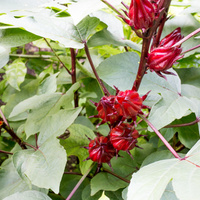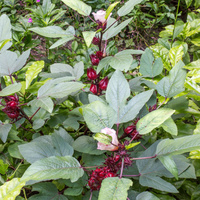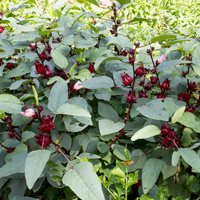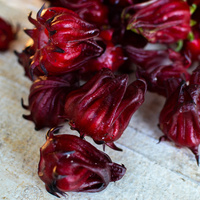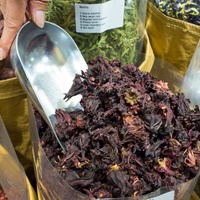Common name: Red sorrel
Other common names: Florida cranberry, Guinea sorrel, Indian sorrel, Jamaican sorrel, Java jute, Jelly okra, Queensland jam plant, , Red tea, Red zinger, Rosella, Roselle, Sorrel, Sour sour
Description
Red sorrel or Jamaican sorrel is a versatile plant originating in the Old World tropics, its natural range extending from East Africa to India.
There are two varieties known in cultivation and they have different uses. One variety, var. altissimais, is cultivated for its fibre and the other, var. sabdariffa, as a food plant. Because their use and also their cultivation is so different, only the food-producing variety is described here.
Closely related to Cotton and Okra (Abelmoschus esculentus), it is a wide-spreading annual sub-shrub 1 to 2 m (3.3 to 6.6 ft) tall, made up of a central stem with semi-woody, wine-red stems branching off all around, and with a vigorous taproot keeping the whole plant firmly anchored in the soil.
The leaves are dull blue-green and vary in size and shape, with the first leaves and the leaves at the top of the plant lance-shaped and entire. As the plant grows, deeply lobed palmate leaves develop, either three- or five-lobed and 7 to 15 cm (2.8 to 6 in) long, mostly on the side branches around the middle of the plant.
The flowers are a typical Hibiscus-shape with five large yellow petals and a red centre. They are borne on the side branches and come into bloom from autumn to winter, in response to shortening day-length.
Each flower lasts for only a day and is set in a green calyx that swells after the flower withers and falls, becoming fleshy, juicy and ruby-red. This covers a small egg-shaped seedpod up to 3 cm (1.2 in) long containing up to thirty very small, finely hairy, dark brown kidney-shaped seed.
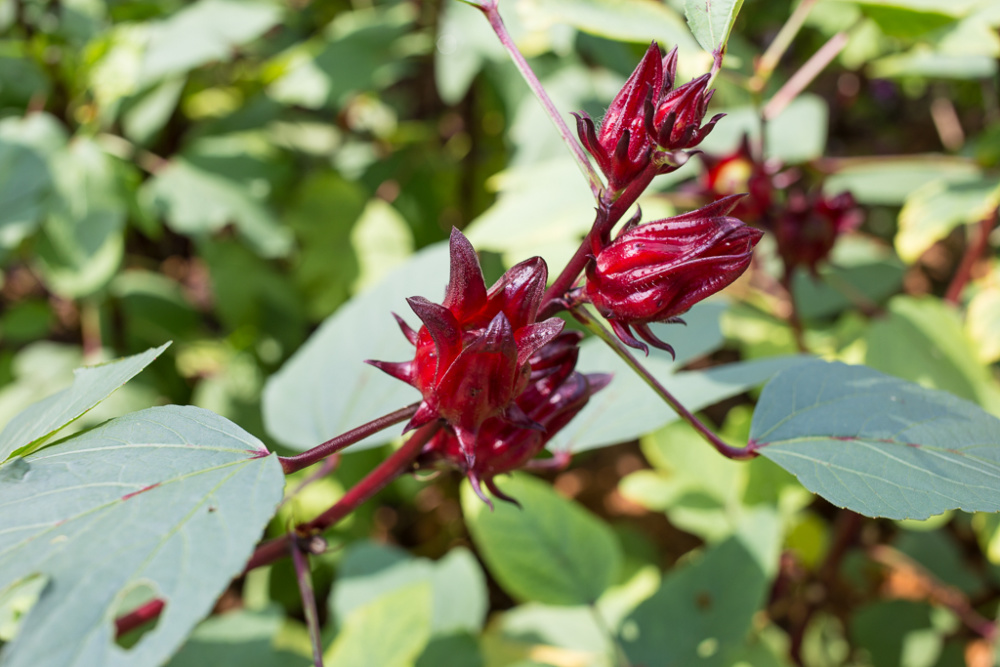
Use
The fleshy calyx has a sourish, cranberry-like flavour and is used fresh or dried to make tea-based beverages, as well as jams, jellies, sauces and fruit syrup (cordial).
Infusions retain the bright ruby-red colour of the calyx and are used commercially as a natural food colouring and for flavouring alcoholic and non-alcoholic beverages, chilled dairy desserts, confectionery and baked goods. In its native region, the calyx is made into teas and cold beverages, with or without a sweetener and spiced with ginger or other spices. Jams, jellies, fruit sauces and drink mixes are made by substituting the calyx for fruit in traditional recipes.
The seed have a crude protein content of about 21% of their dry weight and yield 16% of an edible oil, though questions remain over the oil's suitability for human consumption and it is mostly diverted to soap-making. The whole seed are recommended as bird-feed for chickens and other poultry.
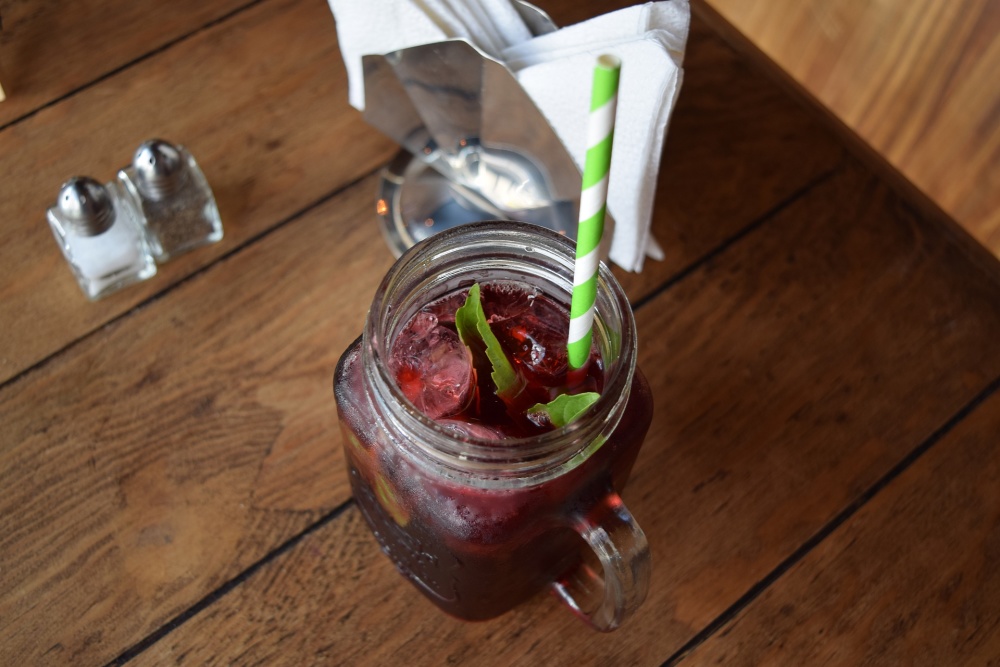
Health use
Teas or infusions of the calyx have shown protective action against high blood pressure in clinical trials, and are prescribed as a liver tonic in traditional medicine. They are rich in both Vitamins C and A.
Climate
Jamaica sorrel grows naturally in humid subtropical and tropical climates, generally areas with annual lows of 12 to 25°C, annual highs of 22 to 35°C and annual rainfall of 800 to 3500 mm. It can also be cultivated with irrigation in much drier areas.
Growing
New plants are usually started from seed broadcast on finely prepared soil that is enriched with organic matter and adjusted to a moderately acid to alkaline pH, generally in the 6.0 to 8.5 range. Alternately, the seed are sown in containers and the seedlings transplanted when they are about 15 to 30 cm (6 to 12 in) tall.
Seed are best sown in spring or at the start of the rainy season in subtropical and tropical areas, when there is sufficient moisture for good germination and growth. The calyces mature around four to six months after the seed are sown, or three weeks after flowering. Yields of fresh calyces average 1.5 kgs per plant in a season or about 8,000 kgs per hectare (7,140 lbs per acre) in commercial operations.
Problem features
The seed are eaten and dispersed by birds and other animals. It is recorded as having escaped cultivation and as a weed of the natural environment in Australia. And is assessed as a moderate weed risk in Hawaii by the Hawaii Pacific Weed Risk Assessment (HPWRA) project.
Where it grows
References
Books
-
Adams, C. D. 1972, Flowering plants of Jamaica, University of the West Indies, Mona, Greater Kingston
-
Dean, J. 2010, Wild Color : the complete guide to making and using natural dyes (Revised and updated edition), Watson-Guptill Publishing, New York
-
Farooqi, A. A. & Sreeramu, B. S. 2004, Cultivation of medicinal and aromatic crops, Hyderabad University Press, Hyderabad
-
Food and Agriculture Organization of the United Nations (FAO) 1988, Traditional food plants : a resource book for promoting the exploitation and consumption of food plants in arid, semi-arid and sub-humid lands of eastern Africa, Food and Nutrition Paper No. 42, Rome
-
Ghosh, T. 1983, Handbook on jute, Food and Agriculture Organization of the United Nations (FAO), Rome
-
Gohl, B. 1981, Tropical Feeds : feed information summaries and nutritive values (Revised edition), Food and Agriculture Organization of the United Nations (FAO), Rome
-
Grubben, G.J.H. & Denton, O.A. (Editors) 2004, Plant Resources of Tropical Africa, Volume 2 : Vegetables, PROTA Foundation, Backhuys Publishers, Leiden
-
Holttum, R. E. & Enoch, I. C. 2010, Gardening in the tropics : the definitive guide for gardeners, Marshall Cavendish Editions, Singapore
-
Khan, I. A. & Abourashed, E. A. 2010, Leung's encyclopedia of common natural ingredients : used in food, drugs and cosmetics, 3rd edition, Wiley Publishing, Hoboken, New Jersey
-
Martin, F. W & Ruberte, R. M. 1975, Edible leaves of the tropics, U.S. Agency for International Development (USAID), and the Agricultural Research Service, U.S. Department of Agriculture (USDA), Mayaguez, Puerto Rico
-
McIlroy, R.J. 1963, An introduction to tropical cash crops, Ibadan University Press, Ibadan, Nigeria
-
Morton, J. F. & Dowling, C. F. 1987, Fruits of warm climates, Creative Resources Systems, Winterville, North Carolina
-
Norrington, L. & Campbell, C. 2001, Tropical food gardens : a guide to growing fruit, herbs and vegetables in tropical and sub-tropical climates, Bloomings Books, Hawthorn, Victoria
-
Parrotta, J. A. 2001, Healing plants of peninsular India, CABI Publishing, Wallingford, Oxfordshire
-
Randall, R. P. 2002, A global compendium of weeds, R.G. and F.J. Richardson Press, Melbourne
-
Randall, R. P. 2007, The introduced flora of Australia and its weed status, Cooperative Research Centre for Australian Weed Management, Glen Osmond, South Australia
-
Tindall, H. D 1983, Vegetables in the Tropics, Macmillan Press, London
-
Wood, I. M. 1997, Fibre crops : new opportunities for Australian agriculture, Queensland Department of Primary Industries (QLD DPI), Brisbane
